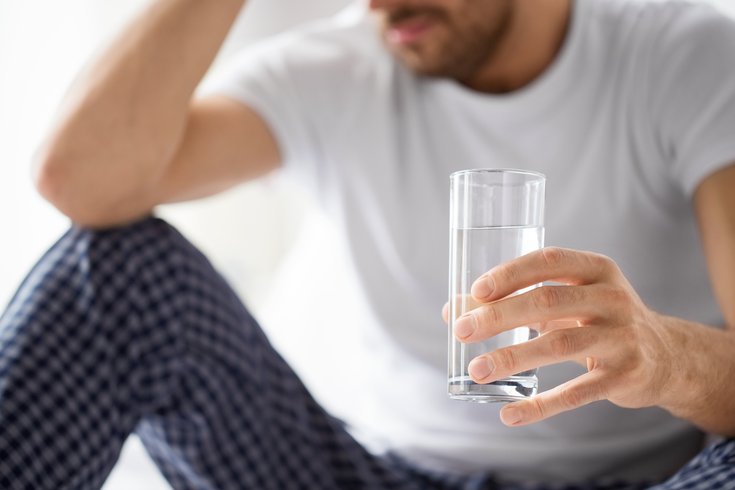
September 22, 2023
 Source/Image licensed from Ingram Image
Source/Image licensed from Ingram Image
Men can experience hot flashes – primarily after undergoing hormone therapy to treat prostate cancer. But they also can be caused by a drop in testosterone levels.
The ties are strong when it comes to men and women coping with the challenges life brings and adopting healthy lifestyles. We're in this thing together.
This column has examined how women can play a critical role in supporting men's health, looked at ways in which men can support women managing menopause, and explored how low testosterone can impact a couple's most intimate relationship.
Though there certainly are distinctions between the biological and social influences on men and women, there are also some notable similarities that tie their fates together and reinforce my mantra that healthy behavior is a team sport. Partnerships – whether with a spouse, partner or friend – increase the chances of success. Another example of these shared life experiences between men and women is hot flashes.
Now, I know what you're thinking, aren't hot flashes exclusive to women? What on earth would cause men to experience the discomfort normally associated with menopausal women? Well guys, it's true. Though not as common in men, men indeed can experience them, and the culprit is something that they will recognize – testosterone.
Hot flashes in both men and women are associated with hormone production. The female experience is linked to a more accelerated, age-related reduction in hormone production. By contrast, the Mayo Clinic tells us that men experience a gradual drop of testosterone – about 1% each year – beginning at age 40. Only 10% to 25% experience testosterone levels that are low enough to trigger hot flashes.
Rather, the primary cause of hot flashes in men is the severe drop in testosterone caused by hormone therapy for prostate cancer. According to Harvard Medical School, deprivation therapy used to treat prostate cancer restricts the production of testosterone, which the cancer needs to grow. A side effect is low testosterone, which causes hot flashes in 70% to 80% of men who undergo the treatment.
Other factors tied to hot flashes in men include stress and anxiety, along with low testosterone unrelated to hormone therapy.
Though the underlying reasons for hot flashes in men and women may differ, the experience has many similarities. Experts have described male hot flashes as surges of heat around the head and neck with the reddening of skin, sweating, heart palpitations and feelings of panic or irritability. They can persist for 2 to 30 minutes, but last less than 5 minutes.
When hormone therapy is the cause, many doctors say the hot flashes and their side effects stop three to four months after treatment. However, some studies have shown that men still experience flashes years after completing treatment.
The American Society of Clinical Oncology offers a number of medical and lifestyle remedies for the reduction and severity of hot flashes. Medical treatments include antidepressants and nonhormonal treatments such as gabapentin and progesterone. Lifestyle recommendations include exercise, a healthy diet and maintaining the proper weight.
Memorial Sloan Kettering Cancer Center advises patients to avoid hot flash triggers like smoking cigarettes, drinking coffee or other caffeinated drinks, eating spicy foods and drinking alcohol. Additional suggestions include dressing comfortably and wearing loose-fitting cotton pajamas to bed, sipping ice water at the start of a hot flash and deep breathing exercises that can help you relax.
The National Institute of Health projects just under 300,000 new prostate cancer cases in 2023. That represents almost 15% of all new cancer cases. With a clear link to prostate cancer treatment, these statistics show that hot flashes in men is a condition with widespread impact.
Beyond prostate treatment, hot flashes can be the byproduct of low testosterone or Low T, particularly in older men. Formally known as male hypogonadism, about 40% of men age 45 and older have low levels of testosterone unrelated to prostate cancer. Studies indicate that the prevalence of low testosterone, or androgen deficiency, has increased. By 2025, as many as 6.5 million American men ages 30 to 79 are projected to have symptomatic androgen deficiency, a 38% jump from 2000 estimates.
So, while not as prolific as the female experience, hot flashes deserve consideration among the challenges men face. Further, this exposure to men can open the door to a more meaningful appreciation of what women regularly confront. Collectively, these shared experiences highlight the common ground between men and women, and the benefits of working together in support of healthy lifestyles.
As is the case in many of the conditions I've covered, diet and exercise anchor the lifestyle response. Once again, healthy behaviors are among the antidotes to the discomfort and disruption of a medical condition.
Healthy behaviors are not a silver bullet, but they certainly represent a way to contribute to the relief of a specific ailment while simultaneously impacting your overall health in a significant way. When your lifestyle is integrated with your most cherished relationships, the mutual support and understanding increases the potential for sustained success and improved health outcomes. Hot flashes serve as one more example that we're in this together, and together we can overcome anything life throws at us.